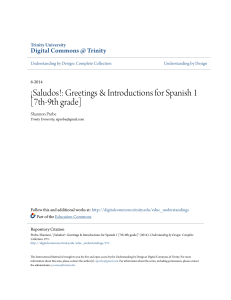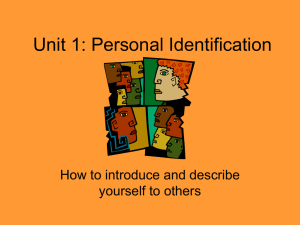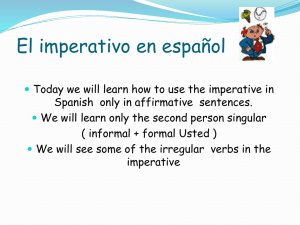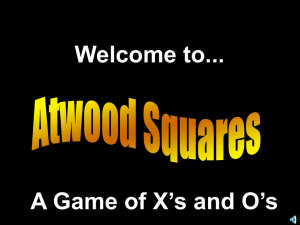Formal vs. Familiar PPT
advertisement
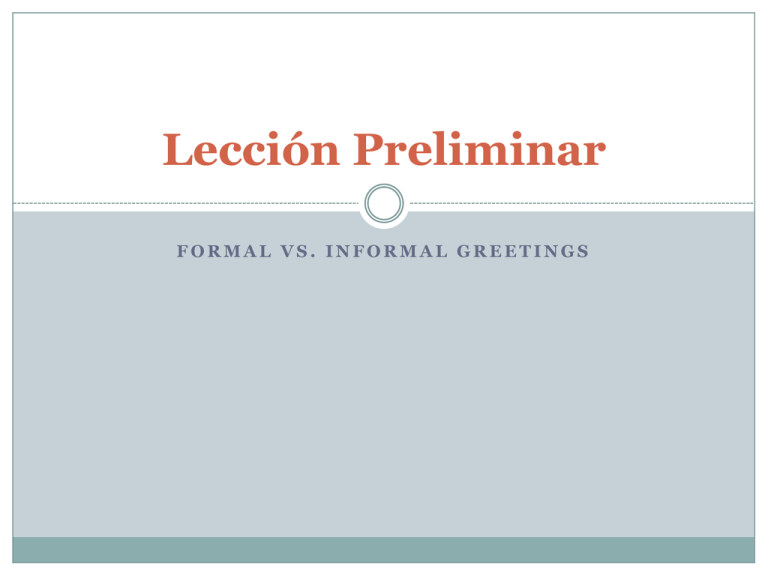
Lección Preliminar FORMAL VS. INFORMAL GREETINGS Formal vs. Informal (Familiar) IN SPANISH THERE ARE FORMAL AND INFORMAL (FAMILIAR) WAYS TO SAY THINGS. THIS AFFECTS THE WORDS WE USE IN DIFFERENT SITUATIONS Expressions Titles Verb endings Formal vs. Informal in English IN ENGLISH, WE DISTINGUISH FORMALITY MOST OF THE TIME BY USING TITLES. For example, you wouldn’t call your principal by his or her first name. You would use Mr. or Mrs. and their last name. IN SPANISH, WE HAVE TWO ENTIRELY DIFFERENT FORMS FOR TALKING TO SOMEONE DIRECTLY THAT DETERMINE WHETHER YOU ARE ADDRESSING THEM FORMALLY OR INFORMALLY. Informal (or familiar) = Tú Formal = Usted #1 “Tú” = “you” informally IT IS INFORMAL OR FAMILIAR. You use this form when you are addressing someone directly that: A person your own age or younger A friend, sometimes relatives A person you call by his or her first name Familiar (informal) The familiar form or the “tú” form will sometimes include the word “tú”, but not always. Informal greetings we have learned so far are: ¿Cómo estás (tú)? ¿Y tú? = and you? = How are you? (tú is often left out) Other informal forms we have learned are: ¿Qué tal? = How’s it going? ¿Qué pasa? = What’s up? ¿Qué onda? What’s up? (Mexico) #2. “Usted” = “you” formally IT IS FORMAL OR RESPECTFUL TO ADDRESS SOMEONE AS “USTED” You use this form when you are addressing someone directly that: a person you don’t know someone older a person with whom you want to show respect, such as in a business or formal situation. Formal (respectful) The formal form in Spanish is referred to as the “usted form” and will most often have the word usted in the greeting, statement or question. Formal greetings we have learned so far are: ¿Cómo está usted? = How are you? (usted is optional, but often left in to accentuate the formality) ¿Cómo está ? = How are you? ¿Y usted? = and you? (formally) Other formal/informal notes IN FORMAL SITUATIONS, IT IS MOST COMMON TO USE: buenos días, buenas tardes buenas noches IN FAMILIAR SITUATIONS, YOU CAN USE THESE OR JUST A SIMPLE “HOLA” IT IS MOST COMMON WHEN ADDRESSING SOMEONE FORMALLY TO USE THEIR TITLE AND THEIR LAST NAME. EXAMPLES: Señor Ramírez (Mr. Ramirez) Señora Ramos (Mrs. Ramos) Señorita García (Miss. García) Las Respuestas Possibles (Possible Responses) (Muy) bien (Very) well (Muy) mal (Very) bad Más o menos So-so Regular Okay Terrible Terrible Estupendo(a) Stupendous Tranquilo(a) Calm Para preguntar al révez (To ask in return) Formal Familiar (Informal) ¿Y usted? ¿Y tú? Sample Conversation Marisol: ¡Buenos días, Señor García! ¿Cómo está usted? Señor Garcia: ¡Hola, Marisol! Estoy bien, ¿y tú? ¿Cómo estás? Marisol: ¡Estoy muy muy muy muy bien! (Estoy = I am) Senor Garcia: ¿Porqué? (Porqué = why) Marisol: ¡Yo saqué una “A”! (I got an A!) Self Check Can you name at least 3 familiar greetings? Can you name at least 1 formal greeting? What is the difference between the two types of greetings? Práctica 3 Familiar Greetings 1. 2. 3. 1 Formal Greeting 1. 5 Possible Responses 1. 3. 2. 4. 5.



